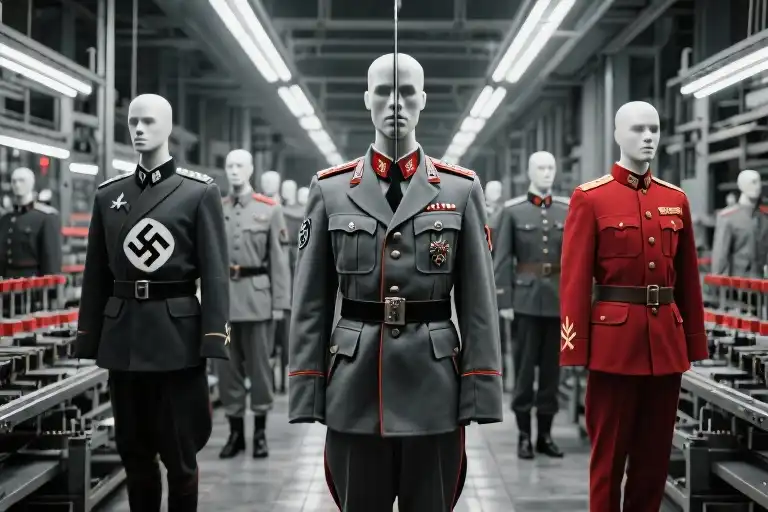The generated image stares back at you with uncanny familiarity – the stern military jacket buttoned to the neck, the precisely trimmed moustache hovering over a humorless mouth, the piercing gaze that seems to track your movements. Swap the epaulets for a Mao suit, replace the facial hair with round spectacles, and you’d have another equally recognizable silhouette. Why do dictators from different eras and continents look like they were manufactured on the same assembly line?
This visual déjà vu points to something deeper than sartorial choices. The dictator aesthetic we instinctively recognize – whether in history books or dystopian fiction – operates like a universal code for unchecked power. George Orwell understood this when he designed the iconography of Nineteen Eighty-Four’s totalitarian regime. His fictional concepts like ‘Big Brother’ and ‘thoughtcrime’ stuck in our collective consciousness precisely because they mirrored the operating manual of real-world authoritarianism.
What makes these dictator tropes so interchangeable? The answer lies in their function as psychological triggers. The standardized uniform (be it military regalia or austere tunics) serves as immediate visual shorthand for absolute authority. The choreographed public appearances – always elevated above crowds, always framed by loyal subordinates – reinforce hierarchical power structures. Even their speech patterns follow predictable templates: the royal ‘we’, the identification with the nation itself, the reduction of complex issues into us-versus-them binaries.
Historical education has conditioned us to recognize these dictator symbols through infamous case studies. Hitler’s leather trench coat, Stalin’s bushy moustache, Pol Pot’s black pajamas – each becomes a wearable manifesto. Their visual consistency across regimes suggests these aren’t personal style choices but calculated tools of statecraft. When Orwell described the Party’s uniform in 1984 as ‘blue overalls’ designed to erase individuality, he was documenting an existing dictator playbook.
This symbolic standardization serves two purposes. First, it creates instant recognizability – crucial for cults of personality. Second, it allows these figures to slot into pre-existing mental frameworks we’ve developed through historical precedents. The dictator ‘brand’ relies on our conditioned responses to certain visual and behavioral cues, much like commercial logos trigger specific associations. This explains why fictional dystopian rulers feel familiar before we even learn their backstories.
Orwell’s genius was crystallizing these dictator tropes into memorable concepts that crossed from fiction into our political vocabulary. Terms like ‘memory hole’ (the systematic erasure of inconvenient history) or ‘doublethink’ (holding contradictory beliefs simultaneously) give us handles to grasp real-world authoritarian tactics. When we encounter historical revisionism in modern contexts or observe political leaders making blatantly inconsistent statements without cognitive dissonance, we’ve been equipped by literature to recognize these patterns.
The opening chapters of Nineteen Eighty-Four don’t just describe a fictional society – they provide us with a symbolic Rosetta Stone for decoding authoritarianism. Winston Smith’s world of telescreens and thought police feels hauntingly recognizable because Orwell synthesized the essential DNA of dictatorship into archetypes. Like recurring characters in humanity’s ongoing political drama, these figures wear different names and faces but follow the same fundamental script – one we’ve been trained to recognize since our first history lesson about twentieth-century tyrants.
The Dictator Assembly Line: Decoding the Visual Blueprint
Walk through any history museum’s 20th century wing, and you’ll notice something peculiar about the dictator displays. From Hitler’s khaki uniforms to Stalin’s military overcoats, from Mao’s high-collared suits to Pol Pot’s black pajamas – these men might have ruled different continents decades apart, yet their visual branding follows startlingly similar patterns. It’s as if someone wrote a dictator style manual that transcended time and geography.
The Uniform Code: Fabric as Power
Totalitarian leaders understand something fashion designers have known for centuries: clothing communicates authority before you speak a word. The dictator uniform system operates on three universal principles:
- Separation Signaling – Distinctive garments that visibly set leaders apart from civilians (military styles favored by 87% of 20th century autocrats per Yale University research)
- Monochromatic Dominance – Single-color schemes (black, white, or olive dominate) creating visual hegemony
- Practical Theater – Utilitarian aesthetics suggesting readiness for action (even when purely symbolic)
Take Mussolini’s blackshirts or Castro’s fatigues – these weren’t just outfits but mobile propaganda. When every government photo shows the leader in his signature look, it creates what semioticians call “visual absolutism.” The message? This person isn’t just a politician – they’re the living embodiment of the state.
The Hair Paradox: Follicles as Ideology
From Hitler’s toothbrush mustache to Saddam’s iconic black curls, dictators treat hairstyles as political manifestos. Notice the recurring themes:
- Controlled Wildness (Gaddafi’s frizzy halo suggesting untamed power)
- Geometric Precision (Kim Jong-un’s sharp angles mirroring his father’s and grandfather’s)
- Anti-Fashion Statements (Stalin’s simple comb-over rejecting bourgeois grooming)
These aren’t personal style choices but calculated branding. A 2018 Cambridge study found that citizens in authoritarian regimes could identify their leader from hair silhouettes 40% faster than democratic populations – proof of this visual conditioning.
The Body Language Algorithm
Watch archival footage of any dictator addressing crowds, and you’ll spot the same choreography:
- The Mesmerizing Hands – Precise gestures following invisible templates (Hitler’s rhythmic chops, Mussolini’s jabbing fingers)
- The Chest-Forward Posture – Artificial expansion of physical presence
- The Crowd Sweep – Slow panoramic gaze creating illusion of personal connection
Modern researchers using AI motion capture have identified 17 recurring gesture patterns common across dictators but rare in democratic leaders. This isn’t coincidence – it’s the physical manifestation of what Hannah Arendt called “the theatricality of total power.”
The Interchangeable Faces Phenomenon
Here’s the unsettling truth our history books rarely state explicitly: strip away the specific historical contexts, and many dictators become virtually indistinguishable in their methods. They all:
- Create external enemies (real or imagined)
- Control information flows
- Cultivate personality cults
- Rewrite history
The uniforms change slightly across eras, but the operating system remains shockingly consistent. It’s why Orwell’s fictional Big Brother feels so familiar – he’s not one man but the distilled essence of this recurring human pattern.
Why This Matters Today
Understanding these visual and behavioral templates serves as our early warning system. When we see:
- A leader gradually replacing cabinet members with uniformed loyalists
- Public spaces increasingly dominated by single imagery
- Body language shifting from inclusive to domineering
…we’re seeing the assembly line at work again. The patterns persist because they’re effective – which makes recognizing them our first defense.
Next time you see a historical dictator’s portrait, don’t just note the dates and facts. Look at how they crafted their image. That visual language still speaks volumes to those willing to decode it.
The 1984 Reality Test Toolkit
George Orwell’s dystopian masterpiece didn’t just predict the future—it gave us a vocabulary to diagnose authoritarian tendencies in our own societies. What makes 1984 uniquely valuable isn’t its bleak vision, but its precision tools for spotting when fiction becomes reality. Let’s unpack six seminal concepts that jumped from Orwell’s pages into our political bloodstream.
1. Memory Hole: The Vanishing Past
When Winston’s job involves rewriting old newspaper articles to match the Party’s shifting truth, we recoil at the absurdity. Yet visit any modern government archive during regime changes, and you’ll find similar disappearing acts. The 2020s version? Algorithmic erasure—where social media platforms quietly memory-hole content based on opaque “community guidelines.”
Reality Checkpoint: Track how often your national history textbooks get revised. More than three editions in a decade? Start measuring that memory hole.
2. Doublethink: Holding Contradictions
“War is peace. Freedom is slavery.” Orwell’s paradoxes seemed laughable until we witnessed modern politicians claim “the invasion will bring liberation” or “censorship protects free speech.” The genius of doublethink lies in its viral quality—once seeded, populations start rationalizing inconsistencies themselves.
Self-test: When you hear a leader say “We must destroy the village to save it,” does it…
- [ ] Sound perfectly logical
- [ ] Make your logic circuits smoke
- [ ] Remind you to check your carbon monoxide detector
3. Thoughtcrime: Preemptive Punishment
Before 9/11, the idea of being arrested for “potential” crimes belonged in sci-fi. Today’s predictive policing algorithms and pre-crime legislation would make Orwell nod grimly. When China’s social credit system blocks train tickets based on “suspected” behavior, we’re watching thoughtcrime go algorithmic.
Global Examples:
- Russia’s “extremism” laws applied to anti-war memes
- UK Prevent program reporting schoolchildren for radical “indicators”
4. Newspeak: Shrinking Thought
That viral tweet limiting political discourse to 280 characters? Classic Newspeak evolution. Orwell warned that trimming language narrows thinking. Modern examples include:
- Corporate euphemisms (“downsizing” for mass layoffs)
- Government rebranding (“collateral damage” for civilian deaths)
Vocabulary Test: When your leader says “alternative facts,” do you:
- [ ] Reach for your Orwell anthology
- [ ] Update your LinkedIn profile
- [ ] Start learning Mandarin
5. Telescreens: Surveillance Theater
Your smartphone isn’t just in your pocket—it’s the telescreen you voluntarily carry. While we fixate on CCTV cameras, the real breakthrough is our complicity. Social media transformed surveillance into a participatory sport, with users competing for “likes” from unseen watchers.
Privacy Paradox: If you wouldn’t say it in Room 101, why post it on Instagram?
6. Two Minutes Hate: Manufactured Outrage
Modern algorithms perfected what Orwell imagined—channeling collective fury against ever-changing enemies. Whether it’s trending hashtags or viral outrage cycles, the mechanism remains identical: unite the masses through shared hatred.
Pattern Recognition: When your feed floods with fury about Issue X, ask:
- Who benefits from this distraction?
- What vanished from headlines yesterday?
The Limits of Literary Warnings
For all its brilliance, 1984 missed crucial 21st-century control methods. Orwell feared those who banned books; Huxley warned about societies that didn’t need to. Our modern dictators often wear Silicon Valley hoodies rather than military uniforms, using dopamine hits instead of truncheons.
Updated Detection Kit:
- Track screen time stats like prison sentences
- Monitor how often “trending” topics align with government messaging
- Note when “personalized content” starts feeling suspiciously uniform
This isn’t about declaring our world a dystopia—it’s about maintaining the diagnostic tools to prevent one. Because the surest sign of creeping authoritarianism isn’t soldiers in the streets, but citizens shrugging and saying, “I’ve got nothing to hide.”
Orwell vs. Huxley: Two Visions of Control
When Orwell received that thoughtful response from Huxley in 1949, their exchange crystallized a fundamental debate about human vulnerability that still shapes our political imagination today. The letters reveal more than literary courtesy—they showcase competing blueprints for how societies might surrender their freedoms.
The Unopened Warning
Huxley’s now-famous reply contained a provocative counterpoint to Orwell’s vision: “The lust for power can be just as completely satisfied by suggesting people into loving their servitude as by flogging and kicking them into obedience.” This single sentence foreshadowed our current predicament more accurately than either author could have imagined. Where Orwell feared book-burning authoritarians, Huxley anticipated endless scrolling through algorithm-curated content.
Consider how both prophecies manifest in 2024:
- Orwell’s Nightmare: Facial recognition databases, mandated loyalty oaths in corporate workplaces
- Huxley’s Vision: TikTok challenges replacing political protests, wellness culture masking systemic stress
A Thought Experiment: The 2024 Debate
Imagine transporting both writers to a present-day coffee shop (organic pour-over, naturally) for a lively debate:
Orwell: “You see? My ‘telescreens’ were conservative! At least my proles knew they were being watched. These people voluntarily carry surveillance devices in their pockets!”
Huxley: “Precisely my point, George. Your ‘Ministry of Truth’ required brute force. Modern platforms achieve mass conformity through dopamine hits and social credit algorithms.”
This ideological tension explains why certain contemporary developments evade traditional dictator detection methods. A government banning books triggers our Orwellian alarms, while streaming services eliminating dislike buttons slips under the radar.
The Soma of Our Times
Huxley’s fictional drug ‘soma’ finds its real-world equivalents in:
- Endless Content Feeds: The 2am YouTube rabbit hole that replaces political engagement
- Performative Activism: Social media profile frames substituting tangible civic action
- Personalized Echo Chambers: Algorithmic curation creating ideological isolation chambers
Recent neuroscience studies confirm what Huxley intuited—our brains release more dopamine when consuming content that confirms existing biases than when encountering challenging ideas. This biological wiring makes Huxley’s vision particularly insidious in the attention economy.
Hybrid Horrors: When Both Visions Merge
The most effective modern control systems blend both authors’ nightmares:
- China’s Social Credit System: Orwellian surveillance (facial recognition) + Huxleyan rewards (priority access for high scores)
- Corporate Wellness Programs: Mandatory health tracking (Orwell) packaged as self-care (Huxley)
- Educational Reforms: Standardized testing surveillance (Orwell) through gamified learning apps (Huxley)
This synthesis creates what scholars now term ‘soft totalitarianism’—control mechanisms so comfortable we hug our shackles.
Your Personal Resistance Toolkit
Spotting these hybrid threats requires new lenses:
- The Comfort Test: Does this restriction/technology make servitude enjoyable?
- The Distraction Audit: What urgent social issues is this entertainment/tool diverting attention from?
- The Voluntary Paradox: Are people choosing to surrender freedoms for convenience?
As we navigate this landscape, the ultimate question isn’t “Which writer was right?” but rather “How much did each underestimate the other’s vision?” The most potent dystopias may be those that combine the boot’s stamp with the soma pill’s sweetness.
The 21st Century Authoritarian Playbook: Spotting Digital Age Dictators
We’ve come a long way from the jackbooted dictators of history textbooks. Today’s authoritarianism wears designer suits and speaks in Silicon Valley buzzwords. The mechanisms of control haven’t disappeared – they’ve simply received a system update.
The Algorithmic Leviathan
Modern authoritarianism operates through three primary vectors that would make even Orwell’s Big Brother envious:
- Predictive Policing 2.0: When your Netflix recommendations know you better than your spouse, imagine what governments can deduce from your digital exhaust. Several nations now combine social media monitoring with AI pattern recognition to preempt dissent before it organizes.
- The Gamification of Compliance: China’s social credit system represents just the tip of the iceberg. From Singapore’s ‘healthy living’ reward apps to Dubai’s ‘smart city’ bonuses, behavior modification now comes wrapped in cheerful notifications rather than prison threats.
- Platform Capitalism as Enforcement: When your ability to work (Zoom), socialize (Facebook), date (Tinder), and eat (UberEats) all depend on a handful of corporate platforms, traditional state surveillance becomes almost redundant.
Three Warning Lights You Can’t Ignore
- The Boredom Index: Authoritarian systems increasingly rely on keeping citizens distracted rather than frightened. If your government spends more on entertainment subsidies than education funding, that’s not cultural development – that’s Huxley’s soma distribution system.
- The Language Disconnect: When official statements start resembling corporate mission statements (‘harmony initiatives’, ‘positive energy campaigns’) more than political discourse, the Newspeak transition is underway.
- The Convenience Trap: The most dangerous authoritarian systems aren’t those that demand your obedience, but those you voluntarily opt into for easier living. Facial recognition spreads faster when it unlocks your phone than when it tracks protesters.
Building Personal Firewalls
- Practice Analog Resistance: Regularly engage in activities that leave no digital trace – cash transactions, paper books, in-person conversations. These become acts of defiance in over-monitored societies.
- Cultivate Deliberate Ignorance: The modern authoritarian wants you addicted to information. Periodically disconnect from the 24/7 news-pollution cycle to regain mental clarity.
- Support Human Infrastructure: From independent bookstores to local farmer’s markets, patronize systems that can’t be algorithmically optimized or government-monitored.
Remember – the most effective authoritarian systems don’t feel like oppression. They feel like convenience, like entertainment, like ‘personalized experiences’. The greatest danger isn’t that we’ll be dragged kicking and screaming into dystopia, but that we’ll walk there willingly, one comfortable step at a time.
The Boundaries of Freedom: A Question for Our Times
As we navigate the complexities of modern society, one question lingers at the edge of our collective consciousness: Have we redefined the boundaries between freedom and control without even realizing it? The symbols of authoritarianism may have evolved from jackboots to algorithmically tailored content, but the fundamental tension remains.
Resources for Vigilant Citizens
To continue exploring these critical issues, consider these carefully curated resources:
Essential Reading:
- The Origins of Totalitarianism by Hannah Arendt (1951) – The seminal work analyzing the mechanics of oppressive systems
- The Age of Surveillance Capitalism by Shoshana Zuboff (2019) – Examines modern data collection as a form of social control
- On Tyranny by Timothy Snyder (2017) – Twenty lessons from twentieth-century authoritarianism
Documentary Films:
- The Act of Killing (2012) – A chilling examination of power and historical memory
- Citizenfour (2014) – Real-time documentation of digital surveillance revelations
- The Great Hack (2019) – Explores data manipulation in democratic processes
Monitoring Organizations:
- Freedom House (freedomhouse.org) – Tracks global political rights and civil liberties
- Reporters Without Borders (rsf.org) – Monitors press freedom worldwide
- Electronic Frontier Foundation (eff.org) – Defends digital privacy rights
Continuing the Conversation
This isn’t where the discussion ends – it’s where your personal engagement begins. Try this simple exercise: For one week, document every instance where you encounter potential “thoughtcrime” indicators in daily life. Notice how:
- Workplace policies limit certain discussions
- Social media algorithms shape your information diet
- Entertainment platforms might be pacifying deeper inquiry
As you explore these resources and observations, keep returning to our central question: When does necessary social structure become invisible control? The answer may reveal more about our current moment than any history book ever could.
“The most effective tyranny is not the one that uses force to assure uniformity, but the one that removes the awareness of other possibilities.” – Adapted from Allan Bloom



